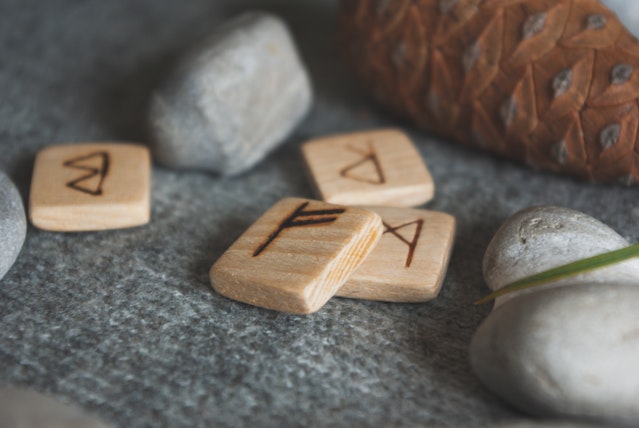
What are runes? Runes were a series of alphabets used by the Germanic peoples between approximately AD 150 and the 17th century.
The word “rune” comes from the Proto-Germanic word “runo” and means “secret, mystery, secret conversation”. This name possibly comes from the legend that the ability to read runes was given to the Norse god Odin after he almost killed himself and spent nine days hanging from Yggdrasil, the World-Tree. Runes were a magical thing. Runes are recognized by their straight lines and sharp angles. This is common to many early scripts because they were carved into stone or wood and it is much easier to carve straight lines than it is curves. They have no horizontal strokes, only diagonals. This is because any horizontal strikes would go along the grain and would be harder to read as well as running the risk of splitting the wood.
We might associate the Germanic peoples with people from modern Germany, but they are much more extensive than this. Germany only became a country in 1871. The Germanic tribes stretched from roughly where southern Germany is now, across into western Russia, and up through Denmark into Scandinavia. The Angles, Saxons, Frisians, Norsemen, Swedes, and Vikings were all Germanic peoples.
All of the Germanic tribes began speaking a common Germanic language. Studies have shown that this was probably situated roughly where northern Germany, Denmark and southern Scandinavia are now. Possibly about 750 BC. By the 1st century AD, when runes began, this common Germanic language had separated into three branches: West, East, and North, but they all still had several similarities. All of the German tribes used the runic alphabet.
Nobody knows where the runic alphabet came from and there is no evidence of its evolution. It appears fully formed on a comb that was found in a bog in Denmark, dated to 150 AD. It would have taken a while for the alphabet to reach the level of sophistication that it had, so the early 1st century is given as a starting date. The origins of the runic alphabet are disputed. It could have been modelled on the Latin alphabet, the Etruscan alphabet, or the Greek alphabet. All three alphabets share similarities, so there is no way of knowing. There is a good argument for it being based on the Latin alphabet because the Latin characters were made from the Greek and Etruscan alphabets. Also, the Romans first came into contact with the German tribes between the 1st century BC and the 1st century AD, which would have given the runic alphabet time to evolve. Still, there is no evidence of its evolution.
Some people think that the runic alphabet could have been invented by a single person, who was possibly a merchant involved with Rome or a mercenary in the Roman army. What a wonderful thought that a single person could come up with an entire writing system.
The runic alphabet went through four distinct periods and there were different numbers of runes in each period. In the way that our alphabet is named after the first two letters (A and B), the first runic alphabet was named after its first six letters. f – u – þ – a – r – k. This is pronounced as Futhark and the first runic alphabet is called Elder Futhark. It lasted from the beginning to roughly 700 AD. It had 24 characters. This transitioned into Younger Futhark from 700 AD to 1200 AD. Younger Futhark only had 16 letters. At this time in history, the Germanic languages were actually separating more, and the number of sounds used in the language was increasing, which means that the reduced number of characters in the Younger Futhark made it harder to write things down. Runes were carried around Europe by the Germanic tribes, especially the Vikings, and these runes became Anglo-Saxon Futhorc runes in England. Examples of Younger Futhark are much more common than Elder and they can be found in many different countries.
After 1200, the Younger Futhark runes evolved into Medieval Futhork runes, but they were only really used in Scandinavia. Christianity had been taking over Europe for hundreds of years, probably since 5 or 600 AD. Most of Europe was Christianized by 700 AD, which explains the death of Younger Futhark runes. The change to Medieval Runes was almost a protest against the Latin alphabets used by Christiana. Runes were seen as pagan and were banned in many countries. Also, as the use of paper and pens increased, it became easier to write curved script than simply straight lines.
The Medieval runes had almost completely disappeared by the 14th century, but they carried on in Scandinavia, particularly Sweden for hundreds of years. In fact, runes were still used in some parts of Sweden until the end of the 20th century. You have a rune on your computer of phone as well. The symbol for Bluetooth is a combination of the runes ᚼ(H) and ᛒ(B), which were the initials of King Harald Bluetooth. And this is what I learned today.
Photo by Dagmara Dombrovska: https://www.pexels.com/photo/wooden-runes-and-stones-scattered-on-wool-plaid-6739035/
Sources
https://www.vox.com/world/2018/6/19/17469176/roman-empire-maps-history-explained
https://en.wikipedia.org/wiki/Proto-Germanic_language
https://upload.wikimedia.org/wikipedia/commons/0/0b/Europe_and_the_Near_East_at_476_AD.png
https://en.wikipedia.org/wiki/Runes
https://en.wikipedia.org/wiki/Elder_Futhark
https://en.wikipedia.org/wiki/Younger_Futhark
https://www.twinkl.jp/teaching-wiki/runes
https://www.vikingeskibsmuseet.dk/en/professions/education/viking-age-people/runes
